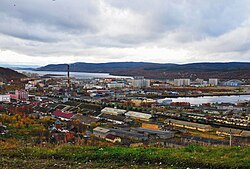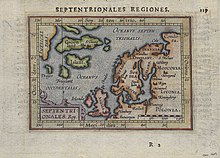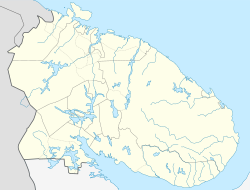Kola, Russia
Kola Кола | |
|---|---|
 View of the town of Kola | |
| Coordinates: 68°53′N 33°05′E / 68.883°N 33.083°E | |
| Country | Russia |
| Federal subject | Murmansk Oblast |
| Administrative district | Kolsky District |
| Founded | 1565 |
| Town status since | August 2, 1965[1] |
| Elevation | 60 m (200 ft) |
| Population | |
| • Total | 10,437 |
| • Estimate (2018)[3] | 9,691 (−7.1%) |
| • Capital of | Kolsky District |
| • Municipal district | Kolsky Municipal District |
| • Urban settlement | Kola Urban Settlement |
| • Capital of | Kola Urban Settlement |
| Time zone | UTC+3 (MSK |
| Postal code(s)[5] | 184380 |
| Dialing code(s) | +7 81553 |
| OKTMO ID | 47605101001 |
Kola (Russian: Ко́ла; Northern Sami: Guoládat; Skolt Sami: Kuâlõk) is a town and the administrative center of Kolsky District of Murmansk Oblast, Russia, located at the confluence of the Kola and Tuloma Rivers, 12 kilometers (7.5 mi) south of Murmansk and 24 kilometers (15 mi) southwest of Severomorsk. It is the oldest town of the Kola Peninsula. Population: 10,437 (2010 Census);[2] 11,060 (2002 Census);[6] 16,541 (1989 Census).[7]
History[edit]
The district of Kolo was first attested in Russian chronicles in 1264. The first documented mention of the town itself dates to 1565—[8] the area was settled by the Pomors, who built the fort of Kola also called Malmus (Russian: Мальмус).[9]
Over time, Sweden extracted the Kola Peninsula from both Russia and Denmark-Norway in a series of wars and resulting treaties.[10] However, in the later Treaty of Teusina in 1595, Sweden acknowledged Russian rights in Kola.[10] Claims from Denmark-Norway remained, however, and in 1582, a Russian voivode was appointed to Kola to provide for better defenses of the peninsula.[8] The voivode governed the territory which became known as Kolsky Uyezd.[8]

During the Russo-Swedish War of 1590–1595, the Swedes failed to capture the fort. In the 17th century, it prospered as a starting point for naval expeditions of the Pomors to Spitzbergen and Novaya Zemlya. The brethren of the Pechenga Monastery moved there as well.
Although it was incorporated as a town in 1784, Kola declined after Russia gained access to the Baltic Sea, and was used by the Tsarist government as a place of exile.[8] Kola was destroyed by a twenty-hour bombardment in 1854[8] by a three-ship squadron led by the Royal Navy sloop HMS Miranda, at the time of Crimean War. As a consequence, Kolsky Uyezd was abolished and merged into Kemsky Uyezd.[8] Kola, while retaining its town rights, lost the status of the center of the uyezd to Kem.[8] The ruined town was later eclipsed by nearby Murmansk, of which it is now commonly considered to be a satellite.
On October 16, 1925—when the Murmansk Governorate Commission meeting initiated work on compiling the lists of the urban and rural localities—Murmansk, Alexandrovsk, and Kola were categorized as urban; however, a recommendation was sent to the All-Russian Central Executive Committee (VTsIK) to demote the latter two to rural localities due to economic conditions, sparse population, low trade volume, lack of industrial enterprises, and "general regress".[11] On March 15, 1926, the VTsIK approved the recommendation, and Alexandrovsk and Kola were re-categorized as rural localities.[11]
At the end of 1934, the Murmansk Okrug Executive Committee developed a plan to enlarge the city of Murmansk by merging surrounding territories into it.[12] Kola was one of the rural localities slated for this merger, and a settlement soviet subordinated to Murmansk was planned to be organized on its territory.[12] The plan was not confirmed by the Leningrad Oblast Executive Committee,[12] but Kola was re-classified as an urban locality by the VTsIK Resolution of August 20, 1935, when it was granted work settlement status.[13] It retained this status until it was granted the status of a town under district jurisdiction by the August 2, 1965 Presidium of the Supreme Soviet of the RSFSR Decree.[1]
Landmarks[edit]
Although earthen ramparts and ditches of the original fortress still survive, Kola's main landmark is the Annunciation Cathedral (1800–1809), which may have been the first stone building constructed in the Kola Peninsula. Other sights include the Museum of Pomor Way of Life and Murmashi, the northernmost spa in Russia.
References[edit]
- ^ a b Administrative-Territorial Division of Murmansk Oblast, p. 56
- ^ a b Russian Federal State Statistics Service (2011). Всероссийская перепись населения 2010 года. Том 1 [2010 All-Russian Population Census, vol. 1]. Всероссийская перепись населения 2010 года [2010 All-Russia Population Census] (in Russian). Federal State Statistics Service.
- ^ "26. Численность постоянного населения Российской Федерации по муниципальным образованиям на 1 января 2018 года". Federal State Statistics Service. Retrieved January 23, 2019.
- ^ "Об исчислении времени". Официальный интернет-портал правовой информации (in Russian). June 3, 2011. Retrieved January 19, 2019.
- ^ Local post info http://www.russianpost.ru/PostOfficeFindInterface/FindOPSByPostOfficeID.aspx?index=184380
- ^ Russian Federal State Statistics Service (May 21, 2004). Численность населения России, субъектов Российской Федерации в составе федеральных округов, районов, городских поселений, сельских населённых пунктов – районных центров и сельских населённых пунктов с населением 3 тысячи и более человек [Population of Russia, Its Federal Districts, Federal Subjects, Districts, Urban Localities, Rural Localities—Administrative Centers, and Rural Localities with Population of Over 3,000] (XLS). Всероссийская перепись населения 2002 года [All-Russia Population Census of 2002] (in Russian).
- ^ Всесоюзная перепись населения 1989 г. Численность наличного населения союзных и автономных республик, автономных областей и округов, краёв, областей, районов, городских поселений и сёл-райцентров [All Union Population Census of 1989: Present Population of Union and Autonomous Republics, Autonomous Oblasts and Okrugs, Krais, Oblasts, Districts, Urban Settlements, and Villages Serving as District Administrative Centers]. Всесоюзная перепись населения 1989 года [All-Union Population Census of 1989] (in Russian). Институт демографии Национального исследовательского университета: Высшая школа экономики [Institute of Demography at the National Research University: Higher School of Economics]. 1989 – via Demoscope Weekly.
- ^ a b c d e f g Administrative-Territorial Division of Murmansk Oblast, pp. 18–19
- ^ Ван Салинген, Симон (Van Salingen, Seemon) (1591). "Сообщение о Земле Лопий: Русские в Лапландии в XVI веке" [Message about Lapland: Russian in Lapland in the 16th century.]. kolamap.ru website (in Russian). Retrieved February 18, 2021.
A Dutch letter about Russian interests in Lapland from 1562 to 1583. Flemish pirates robbed the Edward Bonaventure in 1554 as Edward Bonaventure was returning from Nyonoksa, Russia.
{{cite web}}: CS1 maint: multiple names: authors list (link) - ^ a b A Short History of Finland, pp. 36–37
- ^ a b Administrative-Territorial Division of Murmansk Oblast, pp. 31–32
- ^ a b c Administrative-Territorial Division of Murmansk Oblast, p. 61
- ^ Administrative-Territorial Division of Murmansk Oblast, p. 49
Sources[edit]
- Архивный отдел Администрации Мурманской области. Государственный Архив Мурманской области. (1995). Административно-территориальное деление Мурманской области (1920-1993 гг.). Справочник. Мурманск: Мурманское издательско-полиграфическое предприятие "Север".
- Frederick Bernard Singleton, Anthony F. Upton (1998). A short history of Finland. Cambridge University Press. pp. 36–37. ISBN 0-521-64701-0.
External links[edit]
- (in Russian) Kola entry at Mojgorod.ru


 French
French Deutsch
Deutsch




